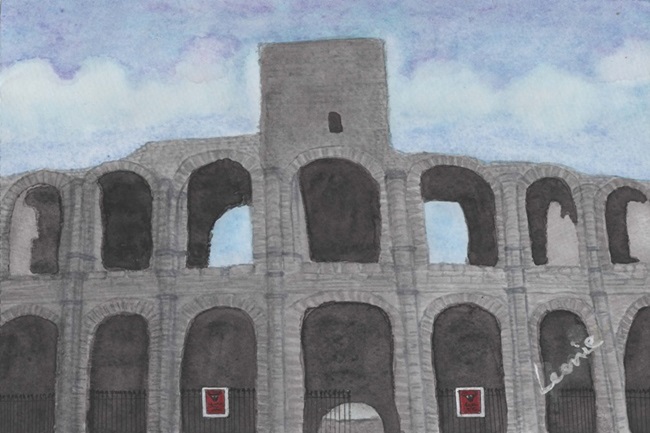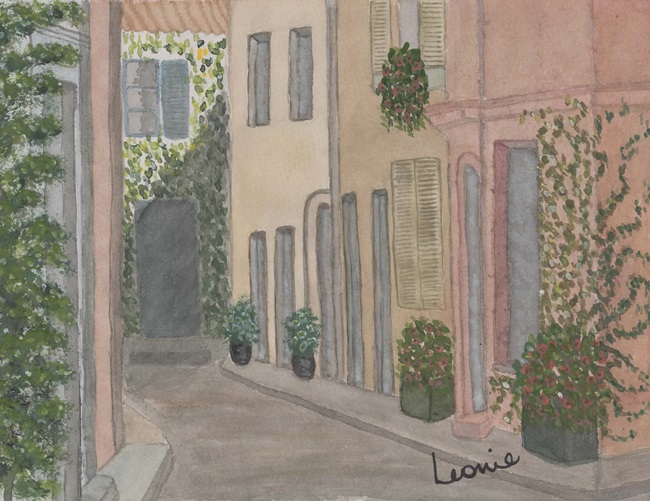Carnet de Voyage: Feria de Riz

Travel notes from the real France. Carnet de Voyage is a weekly personal travel story in France sent in by readers. If you’d like to write a story for Carnet de Voyage, head here for details on how to submit.
As we leave the morning train, then excitedly reel with the crowd heading into the city of Arles, we stumble upon La Feria du Riz – the annual Rice Festival.
‘Look, the Encierro – the running of the bulls in the streets is starting!’
We enter the street, enclosed with wire fences as a sturdy black bull descends from the rear of a truck to pursue teenagers as they run and leap on the barrier. Crowds press against the enclosure anticipating the spectacle. Storm clouds muster overhead as the beast snorts before his next assault. Full of bravado the Arlesian youths descend and stare into the bull’s beady eyes as he taps the asphalt and explodes toward a youngster who clambers up in front of me and I glimpse his face gleaming with fear.
The second bull enters the road and lowers his head – again, the youngsters feel fear and leap as the giant lunges. The railings rattle and a small boy in the crowd squeals – dreaming of the day when he can participate.
The masses yell, they respect the mighty taureaux, and the brave young men as they escape time and again. These young warriors of the street dream that one day they will become toreros, the young men that boogie with the bulls in the ring of the Corrida, the bullfight.
This Encierro is a passage of manhood held at the opening of the Feria as a run-up to the Corrido – the bullfight in the arena planned for the evening. These festivals are held across Spain and southern France to honour their horses and bulls. The animals are welcomed to the city with fanfare including the Cavalcade of Horses.
Arles is the proud gateway to the Camargue. This verdant world is enmeshed within the Bouches-du-Rhône formed between the divided Rhône River after it leaves Arles. The mighty river splays out like a mandolin as it forges towards the Mediterranean in an agricultural, zoological, and botanical marvel – a fragile region of white horses, black bulls, flamingos, rice, and marsh.
We leave the Encierro and wander the alleys between the houses, with their worn patina. Fragrant aromas of paprika, chicken, and seafood assault the air from paellas bubbling on the sidewalks in enormous pans. Every door and window has become a small café for the day where passers-by purchase delicious cuisine. Church bells resound through the laneways echoed by thunder.
But the town square is the heart of the festival – it beats with musicians and marquees. A group of Arlésiennes dressed in traditional dress banter in their provincial patois. Couples dance under the looming sky as their shoes thud the worn paving. Exotic rice dishes and vin de pays – the local wine – are pressed upon us at no charge as we mingle. From the steps of St Trophime Cathedral, we watch children create masterpieces on the pavement.
The maréchal ferrant, the farrier, in his portable workshop, beats a horseshoe. His muscles ripple as the hammer strikes the anvil and sweat drops from his brow. White horses of the Camargue gentle behind him – some boast a pure white coat, and others splotches of grey or fawn. These sturdy animals have evolved to survive in tough humid conditions and are renowned for their courage and capabilities. They work in the Camargue with the gardians and bulls and they shine in events all over Europe.

Arles street © Leonie Pike
We visit some of the celebrated monuments of the city – where first Celts, Greeks, and then Romans lived. Romans created a metropolis here, second only to Rome. Emperors Constantine I, II, and III lived here in the first century. I look at the ruins of the Roman Theatre and listen for the laughter and tears of 8,000, watching Greek comedies and tragedies – a key part of their lives.
Nearby, The Roman Amphitheatre home of the Corrido stands silently. One hundred and twenty Romanesque arches support two tiers – and crowds muster ready for this evening’s event. As last night was cancelled by rain they look at the darkening sky. The Festival Posters tell me that French, Spanish and Portuguese bullfights will be contested by local hero Juan Bautista and others. The modern-day gladiators, as young as sixteen are dressed in designer threads encrusted with gold. Two thousand years ago over 20,000 spectators roared here at chariot races, bloody hand-to-hand battles, and the slaying of exotic animals.
As we bid farewell, the rain begins. The evening’s program – an integral part of the local calendar will disappoint if they cancel.
I look back at Arles and its imperfect splendour and shiver at the possibility of swords slaying sleek bulls in the arena tonight.
Read our other Carnet de Voyage entries here.
Leonie Pike is a Francophile from Adelaide, Australia, who loves to visit France and all its wonders and then share these with others via travel and French language groups as well as her illustrated writing.
Lead photo credit : Arles amphitheatre © Leonie Pike
Share to: Facebook Twitter LinkedIn Email
More in Camargue, Carnet de Voyage, Events, French culture, French festival, South of France
By Leonie Pike
Leave a reply
Your email address will not be published. Required fields are marked *




REPLY